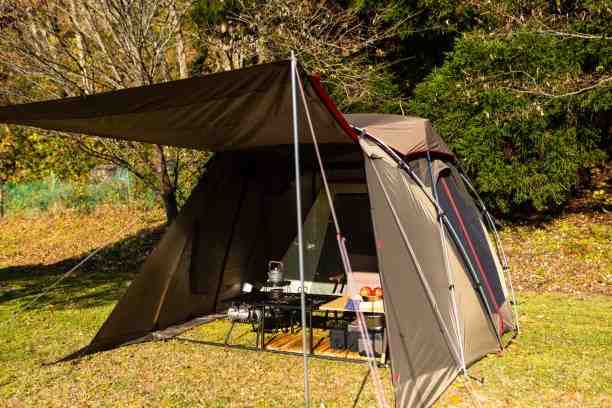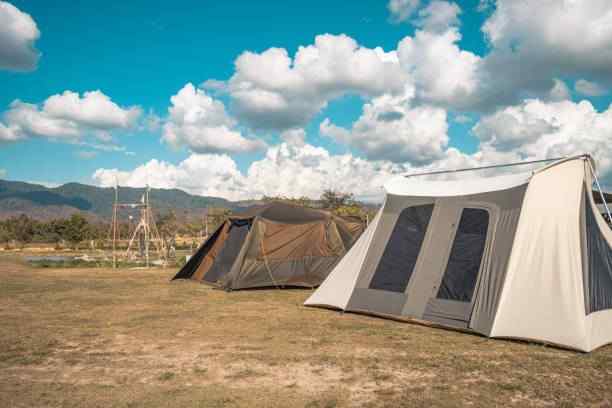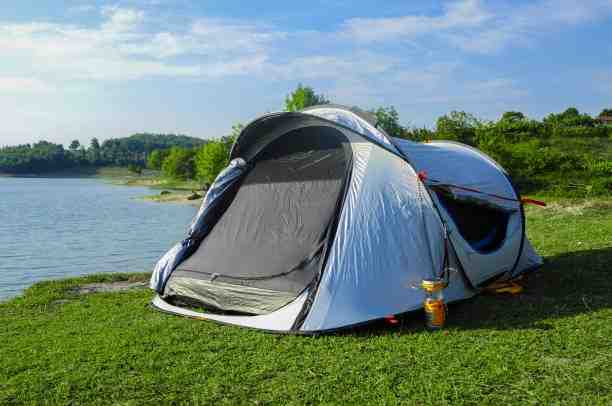
Are you a camper or adventurer who wishes to focus on enjoyment rather than hard work during camping trips? Then Turbo Tents are just what you need. Through their thoughtful designs, Turbo Tents greatly improve the camping experience. Throughout this article, I will outline the benefits of Turbo Tent and also explain various types to better prepare you for your camping adventures. Furthermore, this article aims to provide helpful tips to make the most out of Turbo Tents.
What is a turbo tent?
A turbo tent is designed for fast and simple setup, often in less than 60 seconds. Its “turbo” moniker comes from the speedy setup and takedown time, which can result from pop-up mechanisms or preassembled poles that snap into place. Such tents are useful for camping, attending festivals, or anywhere rapid deployment is necessary.
Key features of a turbo tent include:
- Durable Materials: Turbo Tents are made with durable materials that can withstand high amounts of pressure and different temperatures.
- Fast-Pitch Setup: As the name suggests, Turbo Tents allow fast pull-out, which means faster setup, which is perfect for leisure lovers.
- Different Styles: The turbo tents are not limited to just single and double turbo tents. They are available in various sizes, from 4-person tents to larger tents that are family and group friendly.
- High-Grade Aluminum Poles: The high-quality lightweight aluminum poles used in Turbo Tents make the tents easier to transport.
What are the 7 types of tents?

There is a wide selection of tents available that one can use for camping or related outdoor activities. Below are the two most common types of tents.
1. Dome Tents
Dome tents are one of the most sought-out options for campers because they are easy to use and versatile. These tents have a dome-shaped top that is held up by flexible poles, ensuring they are stable and can withstand the wind. Dome tents are made to fit two or more campers, so they work for smaller groups or families.
2. Extended/Modified Dome Tents
An extended or modified dome is a new type of tent that is an improvement on the original dome tent. Like its predecessor, it also serves the purpose of convenience, but with added space and functionality. The extra dome style gives the living area or vestibule much more room, so it can be used as a storage area, for cooking, or as a communal space for socializing.
3. Tunnel Tents
Tunnel tents have the distinctive elongated shape of a tunnel or a cylinder. These tents are favored by campers for their spacious interiors and superior wind resistance.
4. Geodesic or Semi-Geodesic Tents
The design of geodesic or semi-geodesic tents optimizes their structural strength, providing extreme stability in difficult weather conditions and rough geographical features. Typically, these tents have crossing poles that form geodesic or semi-geodesic shapes, offering balance and resistance to powerful winds, snow loads, and rigorous climates.
5. Cabin Tents
Like a small rustic shelter, a cabin tent resembles a miniature house in the woods and is recognized for the roomy and comfortable living space it provides. These tents have almost vertical side walls, which provide headroom and enable standing and movement around the space. They are great for family camping holidays and prolonged sojourns in nature.
The generous space facilitates the addition of dividers, creating private sleeping quarters. The vertical walls also simplify placing cots, air mattresses, or larger beds. Moreover, cabin tents have large windows and mesh panels for breathability, which offer stunning views of nature.
6. Rooftop Tents
Rooftop tents have become a go-to for people looking for overlanding and off-grid adventures. Unlike traditional camping tents, rooftop tents provide innovative design, which allows them to be mounted on the vehicle roof, making it possible to camp anywhere.
Rooftop tents are easy to set up and offer the convenience of camping above ground. They also come with elevated, sturdy platforms and ladders to facilitate access. These tents are perfect for explorations, especially during long road trips, where one can sleep anywhere the vehicle halts while traveling.
7. Turbo Pop-Up Tent
The Turbo Pop Up Tent is unlike any other product in the market because of its speed and convenience. For the ever-on-the-move people, the Turbo Pop-up Tent could offer a lifeline, as its design allows swift erection of the tent into a usable position. There are various sizes of these tents to accommodate campers of different numbers and types.
Advantages of Turbo Tent use when Camping
Pros:
1. Simple and Fast Assembly:
Setting up a tent may be a rather tiring and time-consuming undertaking, especially after an excessively exhausting day of sightseeing and hiking. No need to worry about struggling with tent assembly anymore; Turbo Tents have come to the rescue.
2. Weatherproof and All-Season:
Having reliable enemy shelter can be very useful, as Turbo Tents are all-weather tents that shield you from rain, wind, and even snow. With their premiere quality materials and strong fabrics, Turbo Tents are all-weather tents that shield you from rain, wind, and snow, providing comfort throughout your camping trip.
3. Cozy and Roomy Turbo Tents:
A good night’s sleep is key to gettingan enjoyable camping experience. Turbo Tents provides a sleeping area that is very comfortable. Turbo Tents are designed with an extended dome shape that gives them generous headroom and wide interiors, which enables their users to move freely inside the tent.
4. New Features that Simplify:
Turbo Tents boast a myriad of features that make ELEMENTS make your camping trip easier and more enjoyable. A number of Turbo Tent models come with dividers or even extra rooms, granting separation and privacy. This is great for families or larger groups who need separation; not only holders or slumber areas have separate sleeping quarters or extra storage. The added convenience for several rooms guarantees an organized and comfortable camping experience.
5. Lasting From Much Warranty:
The tents are specially designed to cope with demanding outdoor activities through the use of rugged materials and reinforced seams. Having your Turbo Tent along for many camping trips ensures its sturdy construction provides consistent shelter and comfort for years of dependency.
Cons:
1. Harder To Store Compactly:
Even though pitching the tent is painless, getting it into a compact size for loading can be quite bulky. If you are traveling in a small vehicle, pack for long hiking trips; some models do tend to take up a lot of space when packed.
2. Adds Less Weight and Volume
Portability is one of the most important considerations when getting camping gear. Turbo Tents are categorized as lightweight and compact. They are easy to transport and store. These tents are made of lightweight materials, which do not compromise their sturdiness.
3. Higher Price Tag
Similar to other quality camping gear, Turbo tents are usually more expensive than normal tents. For camping tents, the price is set at a higher point than most competing brands offer.
4. Reduction in places to set up
Turbo tents typically require a flat, open stretch of land in order to fully spread out. This reduces their versatility if you’re camping in places with rough terrain or lots of rocks and trees.

Turbo tent price:
The price of a turbo tent may change according to the brand, size, and specific features included. Typically, turbo tents can be purchased for anywhere between $200 and $700, and in some cases, even higher.
For instance:
The price for two- to four-person turbo tents is between $200 and $400.
The price for six- to eight-passenger turbo tent models is approximately $400, going as high as $700 or more.
Additional rooms or more expensive materials used on higher-end brands and models will usually cost more than $700.
Features of Turbo Tent that Make It Unique
Turbo Tents are specially designed with some features that differentiate them from other camping tents and turbo tents.
1. Innovative Tent Design:
The Turbo Tent is brilliantly designed to offer aesthetic value while also being ultra-functional. The extended dome shape is not only easy to set up, but it also provides an ample amount of space. Rounded walls allow for ample headroom, making you able to move around comfortably inside.
2. Cutting-Edge Tent Materials
Turbo Tent is known for cutting-edge materials. Each and every component, from the poles to the fabric, is prepped with utmost consideration to guarantee performance. Turbo tents provide weather-resistant fabrics that shield you while also keeping you dry with their high-quality materials engineered for varying surface conditions. Crafted from durable but lightweight material, turbo tent poles offer camping gear stability without adding unnecessary weight.
3. Versatile Tent Options
Different types of camping styles are catered to by the different options provided by Turbo Tent. Whether you are solo or camping in a group, you can always find the right turbo tent configuration easily. Some models come equipped with built-in dividers, which makes them useful for families and larger groups since they are able to have private sleeping quarters or extra storage space. Turbo Tent will be able to fully adapt to your preferences with customizable features.
4. Convenient Setup
Setting up a tent can be so straightforward that it feels effortless, and the Turbo Tent is designed with everything in mind for convenience. Its mechanized setup feature enables pitching the tent within seconds and with no effort on your part. The Turbo Tent boasts of a simple design that allows one to complete the assembly within minutes. Just adhere to the guidelines, and your warm shelter is waiting just moments away.
5. Expert Crafting
The Turbo Tent stands out because of its unique details as well as the quality of materials used on the seams and stitching. Every single element, including stitches and seams, is crafted with precision to meticulous standards. Exceeding benchmarks of outdoor tolerances brings you a trusted and long-lasting camping companion.
What material is better for tent?
A traveler has specific personal preferences, and they change with the camping trips undertaken as well as weather conditions; all these combine to create multiple deciding factors for material selection.
These are some of the most common materials used for tents, along with their specific attributes:
- Nylon: Tents are commonly composed of nylon, a synthetic material. It is lightweight and strong, making it great for backpacking and other forms of outdoor recreation. Tents made from nylon also have good water-resistant properties and dry quickly.
- Polyester: Another synthetic material that is frequently used for tents is polyester. Tents made from polyester are more resistant to UV rays and are more durable than polyester. Casual campers prefer this material because polyester tents are cheaper than nylon tents.
- Canvas: Canvas is a natural fabric that is famed for its longevity and airflow. It is bulkier than synthetic fabrics, which makes it useful for car camping. These tents are better at controlling temperature and minimizing condensation as well.
- Silicone: Nylon and polyester fabrics are often coated with silicone for added water-resistant protection, making the fabric even more useful. Fabrics with silicone coatings are more durable and long-lasting than those with other coatings.
- Dyneema/Cuben: Dyneema/Cuben’s lightweight and strength make it a high-performance material. This fabric is used in camping backpacks and other outdoor equipment that is lightweight and must withstand rough conditions. In addition, Dyneema/Cuben tents are waterproof and highly resistant to tearing.
- When selecting a tent fabric, weight and durability, water and UV resistance, among others, are critical factors to be weighed. Preferences and the specific circumstances of the camping trip will determine the best tent material.
Is tent material waterproof?
Yes, tent materials can be waterproof. Many materials like nylon, polyester, and others have coatings of waterproof materials like silicone or polyurethane and are directly waterproof and thus suitable for tents.
Some materials are fully waterproof on their own, for example, Mylar composite. The most waterproof tent materials are likely DCF (Dyneema Composite Fabric), followed by polyester, cotton canvas, and then nylon. Considered the best lightweight waterproof tent material, nylon is coated with waterproofing layers of silicone, sealed tent seams, and cut with silicone.
Like with other materials, designs, and manufacturing processes, there are advantages and disadvantages to a tent’s breathability and waterproofing features. For example, the more a material is waterproofed, the less breathable it is.
Setting up and Taking Down a Turbo Tent
The quick and user-friendly Turbo Tent setup is perhaps the most notable feature of these tents. Unlike old-fashioned tents that require extensive effort to put together, Turbo Tents come with a streamlined setup that is simple and quick. You can finally spend more of your valuable time and energy enjoying nature instead of struggling with your tent because your Turbo Tent will be ready in mere minutes. Also, the fast takedownallows you to skip the long dismantling process that most tents require.
Tips for Maximizing your Adventure with a Turbo Tent
To make the most of your Turbo Tent experience, here are some useful tips:
- To ensure an efficient and smooth assembly, go through the setup process ahead of time.
- Your Turbo Tent can be complemented by supper tents and additional camping accessories like organizers, portable lights, and even cots to enhance the overall experience.
- Take advantage of the spaciousness and comfort of your Turbo Tent by organizing your camping gear and essentials effectively.
Think about the camping weather for the specific trip date and select from the range of Turbo Tents, be it a summer tent, a three-season tent, or a winter tent.
Conclusion:
Camping enthusiasts keen on trying Turbo Tent Camping models will appreciate the effortless flexibility, reliability, and rugged distinct features they bring to outdoor tent camping. The ease of use teamed with Turbo Tent’s strong materials and protective features makes camping much easier. For an individual going on an adventure, a family looking for a comfy camping trip, or a group who needs a quick setupand pack-away, Turbo Tents always make an ideal companion for any outdoors trip.
FAQs:
Q1. How long does it take to set up a Turbo Tent?
With some practice, the majority of Turbo Tents can be fully erected within 3 to 5 minutes. This includes the folding of the frame and securing the tent. Adding more rooms or awnings may take a few more minutes.
Q2. Are Turbo Tents waterproof?
Yes, please confirm the hydrostatic head rating (1500 mm or 2000 mm) for water resistance, but yes, most Turbo Tents are made from heavy-duty polyester or canvas with sealed seams and waterproof coatings, making them fully waterproof.
Q3. Are Turbo Tents good in windy conditions?
Due to their internal frame and low center of gravity, Turbo Tents are well known for being very stable in strong winds. Proper pegging and guyline tensioning are also critical to fully maximize wind resistance.
Q4. Can one person set up a Turbo Tent alone?
Even though it is quicker and easier with two people, most standard-size Turbo Tents are set up by one person. The exception would be larger family models or if annexes are being added.
Q5. What are Turbo Tents made from?
Materials vary by model:
- Polyester models – Cheaper, dries faster, and is easier to lift.
- Canvas models – Better for prolonged use, more rugged, and offers greater protection against harsh weather.
Q6. Are they suitable for backpacking?
No. Turbo Tents are best suited for car camping, family trips, or base camps, as they are not designed for frequent relocation and are bulkier than what a backpacker would want.
Q7. Do Turbo Tents come with a floor?
Yes, Turbo Tents include bucket-style skirts, which serve as the floor. These skirts not only help keep moisture and dirt away, but they also prevent bugs from getting into the tent. A tent floor saver can also be purchased, which adds extra durability and prolongs the life of the tent.
Q8. Can I add extensions or rooms to a Turbo Tent?
Most Turbo Tents have the following optional attachments:
- Add-on side and front awnings
- Rooms and annexes
- Screens or mesh panels
These are ideal for increasing living or storage space.
Q9. How do I pack down a Turbo Tent?
Packing down, or “backpacking,” is the reversal of the setup process:
- Collapse the internal frame
- Fold the tent neatly.
- Store in the provided carry bag
Tip: For a smoother experience, practice a few times before your first trip so you don’t struggle at the campsite.
Q10. Are Turbo Tents worth the price?
A Turbo Tent is worth the investment if comfort, speed, and durability are priorities. These types of tents provide better weather protection and last longer than many cheaper alternative options.
Q11. Where can I buy a Turbo Tent?
- In the United States, there are outdoor and camping stores like REI, which are matched in Australia with …and Snowys… and BCF.
- You can purchase brands such as OZtrail, BlackWolf, and Darche on eBay, Amazon, or directly from the websites.
Q12. What are the 4 types of tents?
There are 4 primary types of tents: dome, ridge, pop-up, and tunnel. They both have something to offer, depending on the weather, the group size, your preferred camping style, and more, and are great options for different types of outdoor excursions.


